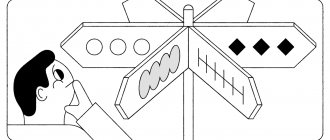Fear experienced in open places or when going outside is experienced emotionally by a person. Agoraphobia with panic attacks is treatable.
The fear of going outside is often accompanied by symptoms such as a panic attack, which is in one way or another associated with direct changes in the nervous system. Therefore, when determining the correct direction of treatment for anxiety conditions, high-quality differential diagnosis comes to the fore.
Brain Clinic specialists have extensive experience in treating agoraphobia and various disorders of nervous activity that cause fear and panic attacks. Our doctors will be able to correctly and safely restore the body’s functioning without any side or negative effects on it.
Call
We help in the most severe cases, even if previous treatment did not help.
| Initial consultation and examination 2,500 | Therapeutic and restorative neurometabolic therapy from 5,000 |
General information
The fear of open space has a triple name - agoraphobia, a word of Greek origin, which is divided into two and literally translated as agora - square, market, phobos - fear. The disease is a mental disorder and is assigned an ICD-10 code F40.0 (Source: Wikipedia). Since in Ancient Greece the agora (marketplace) was a crowded place, the concept of phobia is dual in nature and also includes signs of fear of a crowd, and not just a certain open area.
Unconscious fear in agoraphobia can arise in various situations, from the need to walk through a deserted square or street to a panicky fear of traveling alone on planes, trains, buses. The patient tries to avoid phobic situations, crowded places and companies, because they may require unexpected actions. This defense mechanism is usually developed in response to severe mental shock and previous emotional trauma inflicted by people in real life. A unique difference from other phobias is the onset of the development of fear of open space; it does not arise in childhood or adolescence, but upon reaching 20-25 years of age. It affects 0.6% of humanity.
Agoraphobia was first described by the German physician Karl Westphal. He noted that most often the fear of open spaces develops with various nervous disorders and mental illnesses; it can be a consequence of anxiety or panic personality disorder , other social phobias , panic attacks , neurasthenia , hysteria , hippochondria .
Risk group
Studies have shown that the fear of open doors, whose name is agoraphobia, is more often found among residents of urbanized cities and big cities than among residents of quiet, calm rural areas. Women are also more prone to this disease than men. This is explained by the fact that they are more susceptible to scrutiny and condemnation from society. Moreover, ladies prefer to see a doctor, while men, not knowing how to get rid of agoraphobia, try to drown their problem in alcohol.
People who are psychologically and somatically weakened are more prone to agoraphobia. And also those who have arrhythmia, asthma, epilepsy, hyperthyroidism or hypothyroidism. What is noteworthy is that almost all patients with agoraphobia have problems with orientation in space. Perhaps dysfunction of the vestibular apparatus is also a cause of agoraphobia. Loss of orientation in space appears due to an unclear perception of the environment (large area, crowd).
Pathogenesis
The fear of open spaces is based on the fear of embarrassment in public, being helpless or getting lost, because a panic attack with agoraphobia can occur in a public place and thereby further spur and intensify the phobia. Thus, a person becomes more and more attached to his home and social circle in which he is comfortable. People with such psychological problems are becoming more and more withdrawn, isolated from society, their forays outside their usual habitat (apartments, villas) are becoming increasingly rare and are accompanied by close relatives.
An agoraphobe can have his own social circle and hold meetings, but only in premises and places under his control and that do not violate his comfort, safety, etc. “Comfort zone” in this case is a fairly broad and individual concept - the patient can feel calm in a certain place or with a certain number of people, the inability to maintain eye contact, touch, etc. Violation of any of these factors can trigger a panic attack and the desire to immediately return to the safe zone.
The trigger - the first episode of agoraphobia can be simply waiting for transport in the square or shopping in a large store. The patient does not know how to overcome fear and finds the easiest solution to the problem - to avoid similar situations in the future. A psychological disorder is developed according to the type of conditioned reflex - first, fear arises in a pathogenic phobic situation, then when remembering it, intensifying and filling all thinking, and then transforming into a special type of obsession.
Subsequently, the psychological disorder becomes chronic with exacerbations and remissions. In 70% of cases, agoraphobia leads to the development of depressive disorder and in 44% - phobic disorder .
of panic disorder occur , this significantly aggravates the severity of agoraphobia and worsens its prognosis. A person begins to be “afraid of being scared” - so-called phobophobia develops, which forms a vicious circle that is almost impossible to break on your own without the help of a specialist.
Diagnosis of agoraphobia
The feeling of fear experienced by a person in open places or when going outside is defined in medicine as a phobia and is one of the signs of a violation of the biological processes of the brain, a violation of mental regulation. Today, it is not uncommon to hear or read on the Internet:
"Help! I'm afraid to go outside! When going outside, panic begins. I literally start shaking. I wanted to go to a psychologist but I’m afraid to go out. I'm afraid to tell my boyfriend. He will laugh. I'm already tired. I don’t even want to live.”
For a person, going outside into a large and open space from a protected space (my home is my fortress), the absence of “protective means” nearby, from birth is a stressful situation, which he gradually expands over time. The first stress is the moment of birth. Then the child is afraid to go alone into another room, then from the apartment onto the street, then into the neighboring yard, into another district, into another city, country, etc. It is for these reasons that the child reflexively hides under the blanket or under the bed, climbs into the closet out of fear, thereby, as it were, trying to return as close as possible to the safest space around him - “in his mother’s tummy.” Whenever a person expands his security space, he always learns to control his own security reflex. The first step is always accompanied by a feeling of fear, to one degree or another, from slight excitement to minor worries - this is normal.
In people with increased anxiety, this fear of open, large places, unfamiliar streets, is expressed more emotionally. But in the absence of violations of the biological processes of the brain, a person is able to independently, with the help of the efforts of his own will, cope with the feeling of fear of unfamiliar open places or streets, thereby expanding his own space of safety. When biological processes in the brain are disrupted, the balance of consciously controlled reflex functions is disrupted, and previously acquired skills in overcoming the feeling of fear of unfamiliar open places and streets are lost. Most often, this fear is accompanied by an imbalance of higher nervous activity with the peripheral nervous system, which is expressed in a variety of manifestations and sensations, such as: increased pulse (heartbeat) and blood pressure, feeling of heat, weakness in the legs, loss of orientation, etc., which is very often qualified by various people as VSD (vegetative-vascular dystonia). A feeling of fear in open places and on the street can often turn into panic, which is popularly called a “panic attack.”
Manifestations of agoraphobia with panic attacks
Patient: Male, 27 years old, unmarried, no bad habits, does not work, vocational education, lives with parents. I turned to a psychiatrist, psychotherapist (psychotherapist) on my own, after a correspondence consultation on the Internet. He described his condition as follows:
“At the time of leaving school, after final exams, I was 16 years old, I had
Various fears began to arise when going outside. At first it was a fear that I could overcome and struggled with it myself. But I was advised to see a psychologist, who talked to me, but nothing changed from that. Time passed, and this fear began to bother me, I decided to turn to another psychologist, then to another one. They began to give me different diagnoses - “panic attacks”, “anxiety disorder” and something else, I don’t remember exactly, everyone gave their own diagnosis. But no one really helped. More and more often, panic attacks began to occur when going outside, which were accompanied by fear of going crazy, fear of death, fear of dying from the fact that the heart would stop during an attack, lack of air, increased blood pressure, weakness, chills, “hot flashes” or sudden cold. In a state without attacks, I felt very lethargic, overwhelmed, and lost all interest in anything.
I became afraid to go out and go to the store. Before, before I was 16, I never had this. I have been playing football for myself since childhood. In life, I am a very emotional and impressionable person. During panic attacks, an ambulance was called for me on the street 2 times. I'm afraid I might lose consciousness and die. As a result, I ended up in the hospital with a diagnosis of “VSD of the hypertensive type.”
Four long months of examinations by a neurologist led to nothing. Blood tests were normal, an ultrasound of the heart showed mitral valve prolapse, but according to the doctor, it could not cause such conditions. Ultrasound of the abdominal cavity: kidneys and other organs are healthy. The neurologist advised me to take a picture of the cervical vertebrae. It turned out that I have early stage cervical osteochondrosis and there are vertebral displacements. He recommended a number of medications and referred him to a chiropractor, who said that in addition to his treatment, he needed to see a psychologist.
I went to another psychologist, with a referral from a neurologist. After listening to all my complaints, the psychologist said that it was “Panic Disorder” and I needed to take 20 classes with it. Despite the fact that I feel a sense of fear on the street, I agreed to come to a psychologist, since he said that it is necessary to overcome my fears and train my nervous reactions. I went to all 20 sessions with a psychologist, completed the prescribed course of treatment with a chiropractor, but nothing helped. The neurologist again suggested that I go to the hospital, but I refused because... I no longer saw the point in these endless treatments that did not help me. During all these treatments, on the contrary, I became even worse, and in an unfamiliar place I began to feel 10 times worse than at home.
I have added a fear of open spaces - “agoraphobia”; I practically haven’t left the house for a long time, because... On the street every now and then I was overtaken by panic. I had to quit my job and now I can’t play football either, because... With any physical activity, the head begins to feel very dizzy, a state of lightheadedness and stunned consciousness arises. I don't work because... I feel very bad. I can leave the house, for example, I can freely go to a neighbor’s house, or go by car to visit someone. I’m afraid of being on the street or in large open spaces. Afobazole was recommended on one forum. I took it for a month, it got better, but it didn’t go away completely. Perhaps the fear becomes a little less, but the nausea and dizziness do not disappear. I had to take more Afobazole for it to work. Then I read that afobazole is addictive and stopped taking it. After that it got even worse.
Now there is a fear of going outside, a fear of open spaces, anxiety, panic, and nervousness, the joy in life has disappeared, and I have begun to find less positivity in everything.
I have been undergoing treatment for more than 11 years, and still without results, I am so tired of living in this nightmare. Every night I wake up, go to the window, and it seems to me that I’m going to die soon, I’ve lost interest in life, I don’t want to do anything for myself.”
Based on the results of a pathopsychological examination, a psychotherapist identified a manifestation of anxiety-depressive syndrome, complicated by autonomic dysfunction.
It was proposed to undergo an outpatient course of intensive complex therapy according to an individual scheme with daily visits to the day hospital. But at the patient’s insistence, due to the difficulty of going outside and the fear of large spaces, he was hospitalized to avoid forced movements around the city and going outside. After 7 days he was discharged from the hospital in satisfactory condition. Agoraphobia with panic attacks was not pronounced and the patient could cope with it independently.
He was transferred to a day hospital, where he continued the complex therapy he had begun under the supervision of a psychotherapist. I visited the clinic every day for a month. During this period, I was able to find work and moved freely around the city. Treatment continued on an outpatient basis, with visits to a psychotherapist once a week.
Treatment continued for a year. During this period, the patient fully recovered and his quality of life significantly improved, and he changed his job to a more attractive one. Observed for three years. During this period, no deterioration of the condition was observed.
Most people, unfortunately, believe that the manifestation of agoraphobia is fiction, and panic attacks are whims or a manifestation of bad character that needs to be educated and overcome, sometimes by violent means. Others, who believe that this is a psychological problem and can be solved by educational measures, turn to psychologists.
Causes
Scientists and psychiatrists have not agreed on what provokes the fear of open space. American luminaries claim that it begins with a panic attack, while in Europe it is generally accepted that it is agoraphobia that arises that causes the development of mental disorders and unreasonable fear, while several causes and factors are identified that can provoke it:
- previously suffered traumatic situations and emotional shocks in crowded conditions or in open areas;
- hereditary predisposition to mental illness;
- weakness of the vestibular system, impairing the ability to navigate and see visually clearly in large spaces or in crowds of people;
- developed imagination, which is why agoraphobia is more often diagnosed in women.
Thus, theoretically, the origin of agoraphobia can be biological, genetic or psychosocial.
Treatment of agoraphobia with panic attacks
A feeling of fear in open places or on the street is a problem associated with a mental state disorder and cannot be controlled by the efforts of one’s own will; it requires the mandatory participation of a medical professional with higher medical education, a psychiatrist or psychotherapist.
Agoraphobia with panic attacks can be treated using complex techniques from a psychotherapist. Active neurometabolic therapy, psychotherapy are used, physiotherapeutic procedures are often prescribed, and a daily routine and diet are selected.
Treatment of agoraphobia with panic attacks is selected only individually, only after a thorough examination and identification of the true causes of the formation of a violation of the biological processes of the brain. It is not the symptoms that are felt by the person that are treated, but the cause that the person does not feel. The true reason is sometimes very well hidden from the eyes of non-specialists, and even more so from the person who suffers from it. Treatment of agoraphobia and panic attacks by psychologists or ordinary psychotherapists, without higher medical education and education in psychiatry, should be categorically excluded.
Symptoms
The main manifestation of agoraphobia is the occurrence of anxiety in open areas, in certain similar interrelated traumatic situations, or in other conditions that violate the personal comfort zone, including:
- staying or traveling outside the home alone - walking along deserted streets on foot or by bicycle, going to the store, etc.;
- gathering of a large number of people in public places, incl. public transport, in a store, restaurant, food and clothing markets, at a rally;
- being in an open, deserted space - in a field, park, stadium, beach, etc.;
- inability to quickly and quietly leave an event or establishment - a cinema hall, a hairdresser, a party;
- places where there is a feeling of danger, being trapped - the risk of freezing, overheating or being attacked;
- conditions where the patient has previously experienced feelings of inexplicable fear and panic.
The intensity of anxiety and the desire to avoid a stressful situation can be of varying degrees, causing maladjustment and complete homelessness. The manifestations of anxiety are similar to those of generalized anxiety disorder and can be combined with depression , depersonalization , obsessive symptoms and various social phobias. In addition, they highlight anticipation anxiety and the desire to avoid a stressful situation, that is, fear and panic can arise even several hours before a person finds himself outside of his comfort zone - going to the store, riding a bus, etc.
Outside the comfort zone, the patient experiences unconscious, inexplicable fear and begins a panic attack, which can last 10-15 minutes (in rare cases, slightly more than half an hour). Panic fear triggers the release of adrenaline and the body is in a state of choice - flight or fight. The main symptoms of a panic attack are:
- strong heartbeat;
- chest pain;
- increased sweating ;
- shiver;
- general weakness;
- dizziness;
- nausea;
- sensation of either cold or heat;
- sharp loud breathing;
- difficulty speaking, including stuttering ;
- loss of control over emotions and behavior;
- causeless melancholy;
- fear of stroke and death;
- possible fainting .
Manifestations of agoraphobia - fear of open places, fear of going outside
The main, leading symptom of agoraphobia is the fear of open spaces, the fear of going outside, the fear of entering large rooms (halls, recreation rooms, long corridors, rooms with high ceilings, etc.). Agoraphobia can manifest itself in the form of a variety of symptoms, which can manifest itself in the form of: - uncontrollable, unclear fear; - in the form of suffocation, palpitations, a lump in the throat and other somatic phenomena; - weakness in the legs or throughout the body; - internal trembling; - increased sweating, feeling hot, feeling cold
However, most often agoraphobia is accompanied by several symptoms at the same time, which can be combined into one well-known term - panic attack. Therefore, doctors most often treat agoraphobia with panic attacks.
Often associated symptoms of agoraphobia
- Phobias are obsessive fears. Phobic anxiety
- Feeling afraid in open places or on the street
- Fear of leaving the house alone
- Fear of riding in public transport
- The need to avoid certain places or activities
- Fear of fainting
Treatment of disorders with manifestations of feelings of fear.
Tests and diagnostics
To confirm the diagnosis of agoraphobia, several mandatory criteria must be met:
- The manifestation of psychological or autonomic disorders should be the primary way of expressing anxiety, and not a secondary consequence of symptoms such as delusions, obsessive thoughts , etc.
- The cause of alarm should be only or predominantly two triggers - large crowds of people, being in a public place, in open space, moving outside the home and traveling unaccompanied by a loved one.
- The patient has or has previously recorded a pronounced desire to avoid phobic situations, up to complete maladaptation and reluctance to leave the house.
The first fear is the main anchor
The complexity of a phobia is that even an experienced psychotherapist is not always able to discern where the roots of the problem lead. But when it comes to VSD sufferers, then in the overwhelming majority of cases the trigger is the most common panic attack, which for certain reasons did not occur at home at the usual time, but in public. And it was a real nightmare: there were no household members or a life-saving first aid kit nearby, everything around was unusual, and most importantly, there was a clear realization - this is how I will die among these strangers, no one will help me, they will only discuss and laugh.
The subconscious mind remembered this panicky conclusion and decided that a public place or just a street was a deadly place. This is how the main anchor appeared. As soon as you move it, the clear bottom of the soul becomes cloudy and frightening. Having returned to this place again, the VSD student will subconsciously understand: death is somewhere nearby. And nature, which protects its creatures, will never allow this stupid death. Adrenaline will immediately begin to release, the heart will pound furiously, and the person will feel the rush of insane panic. It’s as if the body itself is screaming at him: run away, run before it’s too late!
Having succumbed to his fear several times, the VSD worker tightens his anchor more and more, and one day he realizes: the fear of leaving the house has become so strong that, perhaps, it will soon leave him without friends, travel and a job.
There are other causes of agoraphobia that do not depend on whether a person has VSD. These include hereditary factors, childhood psychological trauma, the effects of taking certain medications, and even a person’s specific personality type. But whatever the reason, is there a chance to independently eradicate this terrible phobia that has narrowed your life to the size of an apartment?
Symptoms - how does fear manifest itself?
The manifestation of the disorder is characterized by the emergence of an incomprehensible, previously unexperienced fear at the moment of leaving one’s home. A person is seized by severe inexplicable anxiety, which is accompanied by intense autonomic failures. As soon as the person goes outside, she feels a trembling in her body. Her legs give way, her limbs get cold. She finds it difficult to take a full breath. He feels a squeezing headache and a feeling of heaviness in his chest. The heart rate increases. There is a urge to urinate. The body becomes covered with cold, sticky sweat. There may be a feeling of unreality of what is happening. The person loses touch with reality, does not understand where he is, what time it is.
These unfamiliar, extremely unpleasant sensations are alarming and frightening. Unable to give a correct interpretation of what is happening and attaching enormous importance to symptoms that arise unexpectedly, a person becomes convinced that “it is not safe to be outside the home.” Such a stereotype is firmly fixed in the subconscious and begins to control the behavior of the individual. These attitudes work proactively, trying to protect a person from repeating a painful episode. A warning mechanism is activated: the individual stops going outside his home.
At the same time, the person is seized with real horror only at the mere thought of being outside the apartment. Symptoms of panic arise already when anticipating leaving the house. To be in a comfortable living space, a person takes decisive steps. For example, he gives up a prestigious position and starts working from home. Making ridiculous arguments, he negotiates with his relatives to supply him with food and medicine.
Voluntary seclusion negatively affects the social sphere. The person stops communicating with friends and does not make new acquaintances. Refuses to attend sports clubs. Doesn't go to cultural events. Doesn't go outdoors, doesn't travel. The outcome of such isolation is an even greater aggravation of anxiety and the emergence of fears with a new plot.
How to overcome the fear of leaving the house?
To choose the right treatment strategy, it is necessary to determine the true causes of fear. The main condition for healing is timely seeking help, since phobic fears are characterized by rapid progression and aggravation of symptoms.
How to overcome annoying uncontrollable fear? Help is provided in several stages.
Examination by narrow specialists
To exclude somatic and neurological pathologies, you should consult and undergo examination by a cardiologist, neurologist, or endocrinologist. The next step is a visit to a psychologist who will conduct a diagnosis to clarify the characteristics of the clinical picture of the disorder. The specialist will ask the client to undergo several special tests that can be used to accurately diagnose a person’s condition. In the future, if necessary, the patient will be referred to a psychotherapist or psychiatrist.
Drug therapy
Pharmacological drugs are used only in severe cases of the disorder or to relieve panic attacks. Antidepressants with sedative effects and tranquilizers of the benzodiazepine group are most often used in treatment. The choice of a specific drug and its dosage is made after assessing the likely benefits and risks.
Psychotherapy
The main emphasis in the treatment of obsessive fears is on individual psychotherapeutic work. Methods of cognitive behavioral therapy, gestalt therapy, and Ericksonian hypnosis have proven their effectiveness. To choose the optimally suitable and effective method for freeing yourself from fear, you can seek help from the Irakli Pozharisky Psychology Center.
During the meeting, the specialist carefully examines the client’s psycho-emotional state. During a confidential conversation, past factors that served as the foundation of the problem will be identified. A psychologist will help identify destructive stereotypical ideas and harmful attitudes inspired from outside. The specialist will advise and assist in understanding repressed attitudes and resolving internal conflict.
Methods to combat agoraphobia
Many VSDers withdraw into themselves, cherishing their fear and embarrassed to tell anyone about it. Indeed, it is not always pleasant to come to the doctor and say: “I’m afraid to leave the house, I’m afraid to go outside.” Dystonics subconsciously expect negativity and condemnation from any person who learns about their problem. And experts agree that the main barrier in the treatment of phobias - any phobias - is the relationship of the VSD person with his own family.
Everyone is familiar with phrases like this: “You’re overthinking a lot, relax!”, “Well, you’re so little, you’re scared of nonsense!”, “Don’t go there alone, otherwise you’ll have a heart attack!”, “It’s probably a premonition of trouble, Better stay at home!”
It is advisable to begin working with agoraphobia by correcting intrafamily relationships. It is important that the patient’s loved ones understand: what their loved one feels is not a joke, he really carries a mental disorder within himself, which progresses and over time can destroy the personality! There is no need to overprotect the VSD, scaring him even more, but you should not treat him like a spoiled child demanding attention. As soon as the psychiatrist begins working with his patient, it will be right if the family gets involved and follows the doctor’s recommendations.
Strengthening the nervous system greatly facilitates treatment. Yes, the fear of dying on a bus and proper nutrition seem to have little connection with each other, but extra physical and mental strength will be beneficial. Yoga and meditation also have beneficial effects. Some VSDers look for a partner with a similar mental illness and cope with the problem together. If there is a “mirror” nearby that fully understands and gives practical advice, the results will not be far off.
But still, the best way out of the situation would be a visit to a psychologist who can determine the roots of the problem and correct the patient’s attitude towards his fear of leaving the house. Medicines are included in treatment and have an auxiliary function - to normalize the current condition.
In the end, remember - you are far from alone with your misfortune, and it will not become a death sentence if your life is filled with interesting hobbies and the desire to improve yourself. Such famous people as Marilyn Monroe, Woody Allen and Macaulay Culkin also “had the honor” of becoming acquainted with agoraphobia, but, as you can see, they did not become its hostages.











